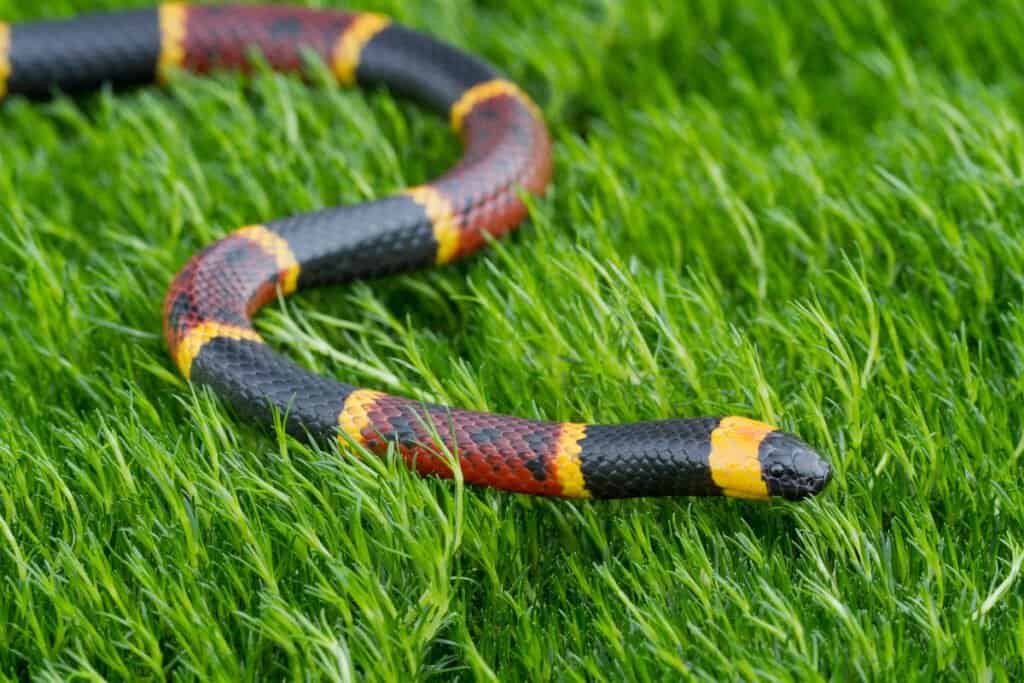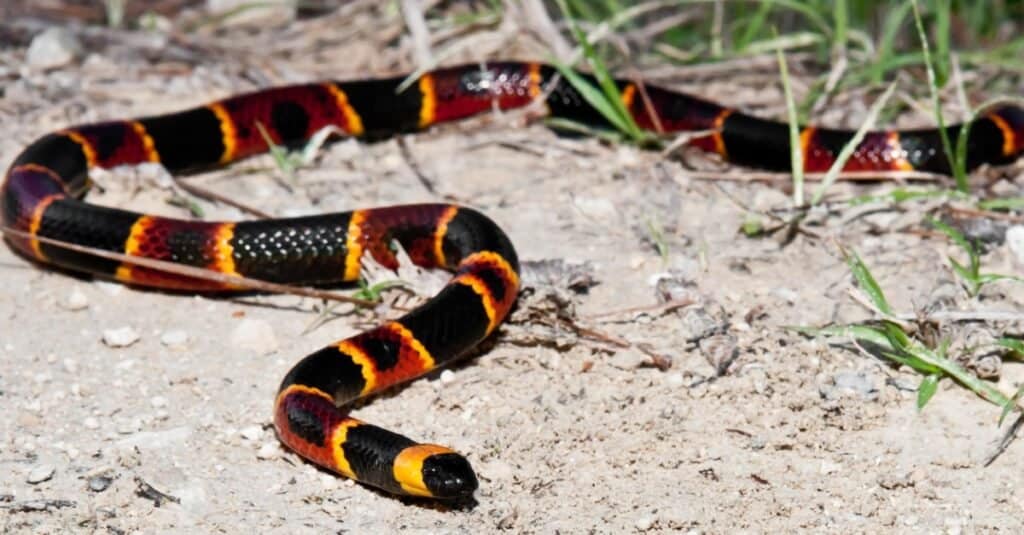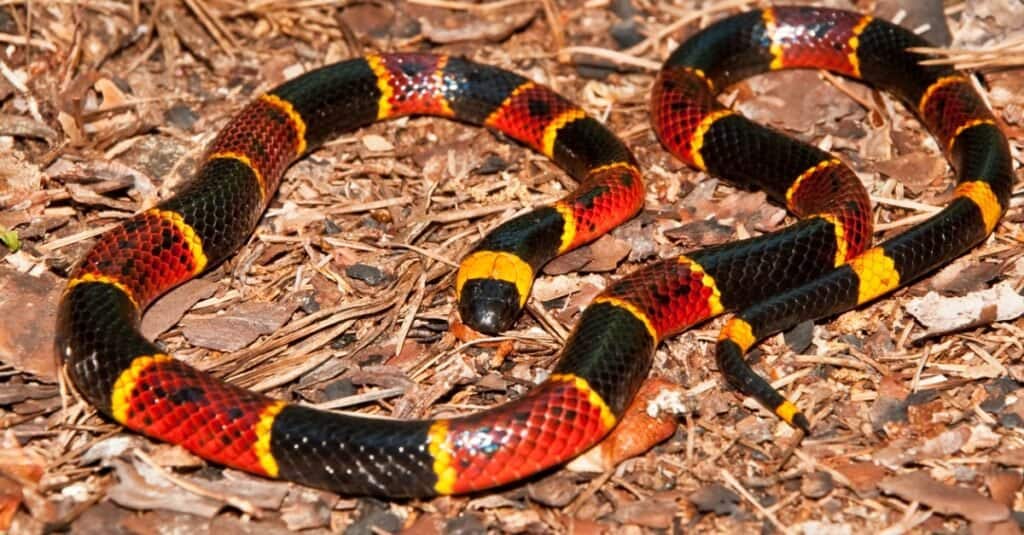The brighter and more vibrant the color is in the animal kingdom, the more poisonous or venomous the animal can be. This notion proves true on coral snakes, as their bright patterns of red, yellow, and black rings are enough indication to predators and threats to stand back. Coral snakes are known predators in the wild and often prey for larger animals.
But are coral snakes poisonous or dangerous? Handling a coral snake is a terrible idea, especially in the wild. Coral snakes are not poisonous. Instead, they are highly venomous and very dangerous to humans. To give you a clear picture of how potent the coral snake’s venom is, they have one of the most potent venoms in the world, next to a black mamba. Yet, unlike most venomous snakes, they are considered less dangerous than many snake species because the way coral snakes deliver their venom is less effective than others.
Coral Snake Bites

Coral snakes have sharp fangs that give painful bites.
©Mark_Kostich/Shutterstock.com
Like many snake species equipped with venom, coral snakes bite with their sharp fangs. But unlike most venomous snakes, the coral snake’s fangs cannot be retracted and are relatively weak. The coral snake’s venom is highly toxic, even more potent than a rattlesnake. Yet, thanks to their fixed fangs and tiny mouth, coral snakes cannot easily penetrate through human skin, especially through leather boots. Their venom can be highly toxic, but they cannot effectively deliver a copious amount of venom in one bite, making their venom less deadly. Coral snake bites can bring intense pain, and if left medically unattended, it can even lead to cardiac arrest. Compared to other venomous snakes, coral snake bites do not usually show injury or significant tissue damage.
When coral snakes bite, they hold on, giving rise to the popular myth that they must chew to envenomate. Experts say this is more likely because they’re trying to not let their prey get away, because many coral snakes eat other snakes. This behavior is common among snakes that eat other snakes.
Since their fangs are relatively short, weak, and fixed to the roof of their mouth, they may hold on to their prey or adversary for some time to deliver the venom effectively. Coral snakes’ fangs are constantly out and firm, making it more convenient for them to bite humans when handled. They are most closely related to cobras, mambas, and other elapids. However, unlike its bigger cousins, coral snakes are not aggressive and are rather shy. They are more likely to get away than bite. But when provoked or handled, they can lash out and attack.
Are Coral Snakes Dangerous to Humans?

Bites from coral snakes can result in muscular paralysis.
©iStock.com/JasonOndreicka
While their venom is not delivered as effectively as other deadly snakes, coral snakes can still be dangerous to humans because of the symptoms their bites can bring. Coral snake bites can be extremely painful and can cause muscular paralysis. The coral snake’s venom is one of the most potent venoms in the animal world because it contains powerful neurotoxins. The neurotoxins are responsible for the rapid paralysis and respiratory failure in the coral snake’s smaller prey. In humans, coral snake bite symptoms can appear a few hours after the bite, including swelling. Sometimes, coral snake bite symptoms can be delayed up to 12 hours, making people think that there might have been no envenomation that happened. But when left untreated by an antivenom, the neurotoxins will begin to disrupt the nervous system, interrupting connections between the brain and the muscles. Then, more severe symptoms may develop, such as:
- Slurred speech
- Intense pain
- Double vision
- Muscular paralysis
- Signs of shock
- Change in skin color
- Headache
- Nausea and vomiting
- Convulsions
- Drooping eyelids or ptosis
- Stomach pain
- Difficulty swallowing
- Respiratory or cardiac failure
Of over 4,000 snake species on the planet, around 600 are venomous, and approximately 30 venomous species are known to lurk across the United States. Among these highly venomous snakes are the notorious rattlesnakes, cottonmouths, cobras, and copperheads that all share their number of fatality counts on humans. However, because the coral snake doesn’t bite often, its venom is delivered less effectively, and because of antivenom that can fight the snake’s toxicity, the coral snake has the lowest fatality count among the venomous snakes mentioned.
Are Coral Snakes Poisonous?

Coral snakes are venomous and bites from them can result in respiratory failure.
©iStock.com/JasonOndreicka
Coral snakes are venomous, but they are not poisonous. Since “poisonous” refers to developing symptoms after ingesting or touching an animal, coral snakes do not fall under this category. However, it is still dangerous to handle coral snakes because of their potent venom. Coral snakes inject neurotoxins through their fangs. This neurotoxic venom is deadly for smaller prey and is almost equally dangerous for humans. Neurotoxins block significant neurotransmitters called acetylcholine that help activate body muscles. Envenomation can lead to blockage, resulting in weakness, paralysis, respiratory failure, and even cardiac arrest.
Are Coral Snakes Dangerous to Dogs?
Any venomous snake bite can cause different levels of complications to your dogs. When a coral snake bites your canine, it can be highly toxic as the venom immobilizes the dog’s respiratory center in a slow yet lethal manner. Symptoms will typically take effect 18 hours after the bite but may last up to 10 days. Muscle paralysis in dogs can hinder their breathing, which can be fatal. Coral snake bites on dogs do not often cause swelling, making it more difficult to notice.
How to Avoid Coral Snake Bites
Coral snakes are not known to be aggressive, so the best way to avoid them is to stay out of their way. Most reports of coral snake bites happen when handling one, so it is best to admire them from afar, especially in the wild. If you encounter a snake in its natural habitat, stay calm and let it retreat, and search for cover. Coral snakes often avoid interaction and will only bite as a last resort. It is also best to wear boots and leather gloves when working outside, as coral snakes cannot penetrate through these items.
The photo featured at the top of this post is © Mark_Kostich/Shutterstock.com
Discover the "Monster" Snake 5X Bigger than an Anaconda
Every day A-Z Animals sends out some of the most incredible facts in the world from our free newsletter. Want to discover the 10 most beautiful snakes in the world, a "snake island" where you're never more than 3 feet from danger, or a "monster" snake 5X larger than an anaconda? Then sign up right now and you'll start receiving our daily newsletter absolutely free.
Thank you for reading! Have some feedback for us? Contact the AZ Animals editorial team.






